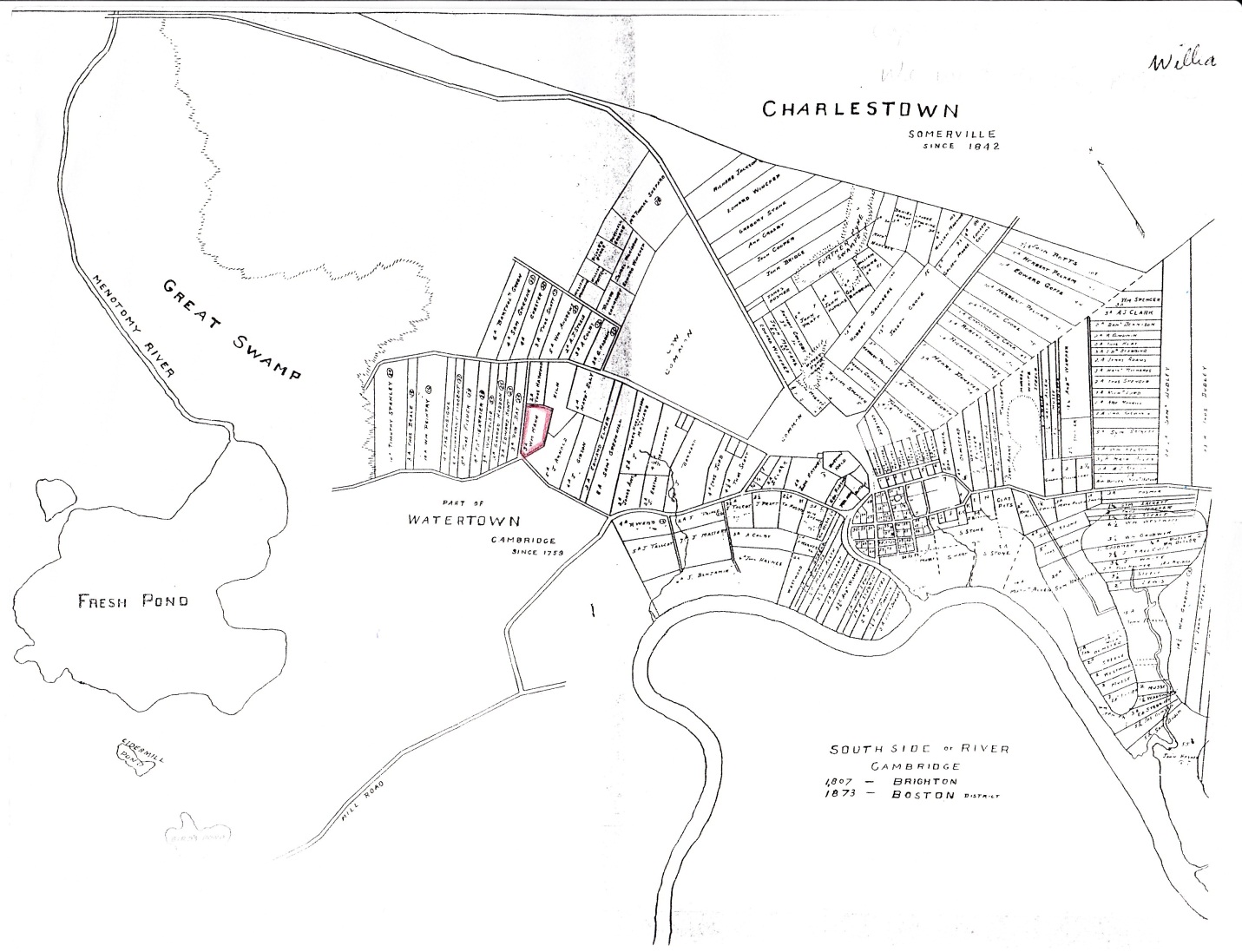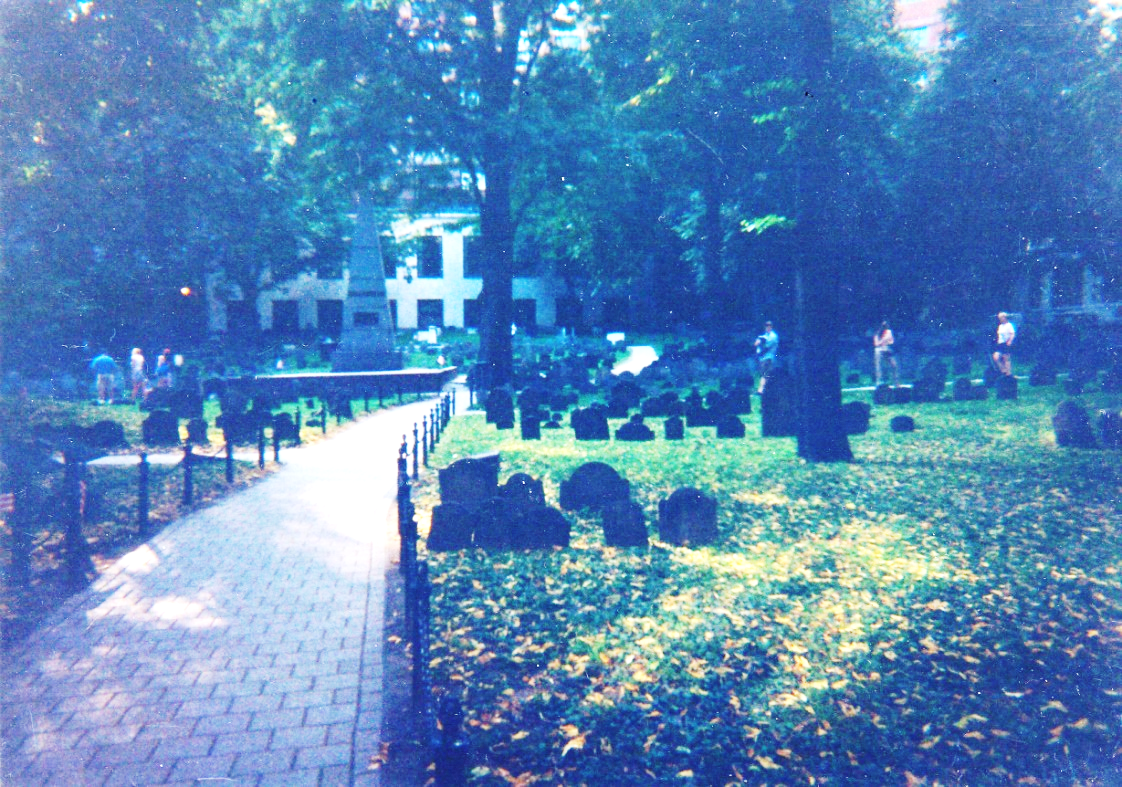William Mann ( -1662) and Mary Jared ( -bef. 1657)
Click here to go to a condensed version of this biography.
Most of the little we know about William and Mary Jarred (or Gerrard) Mann comes from the journal of their son, Samuel. An extract from this journal says that if his "memory doth serve, my father William Man was born in the other England In the county of Kent (In what town I cannot learn) about ye yeare of Lord 1607 being ye youngest of eleven children of what age he as And in what year he came Into the land I cannot learn, only this much he was one of ye first comers into ye Colony of ye Massachusetts."1, 2 Some researchers suggests that William Mann may have come from Hatton Braddock, Kent, England.1, 2, 3 We do not know what ship he came in or when he met Mary and whether they were married in England or in Massachusetts. They seem to have been humble, quiet people because there are few references to them in the public records. Putting their story together is difficult.
We know that William immigrated to New England sometime before 4 August 1634, when he received a land grant in Newtowne, (now Cambridge) Mass. That is the first solid record we have of him. On 4 August 1634, William Mann was granted a three-acre house lot in the Westend Field, the new area which was being subdivided after the original 64 lots in the village were full. That is where William and Mary lived the rest of their lives. This lot was at the current corner of Sparks and Huron Street, running along Huron to Concord Ave. There was a clay bank next to William’s lot, and eventually a brick kiln was built there.
In 1632, a congregation from Braintree, England arrived in Massachusetts. They originally stopped at Mt. Wolliston but were ordered by the General Court to move to Newtowne in August. Their coming almost doubled the population of Newtowne to around 40 families. We believe that William Mann must have arrived in Newtowne at the same time as, or after, the Braintree Company, because the site of the lot assigned to him was outside the pales, rather than on the inside of the pallisade with the first people to arrive.
The following map has his house lot outlined in red. Note that Thomas Fisher, another Johnson ancestor, had a lot six lots to the east of the Manns.

A meeting house was also built in 1632, but there was no minister until 1633 when the settlers of Newtowne sent an invitation to Thomas Hooker, who came, bringing with him the Reverend Thomas Stone as his assistant.
In the 20 August 1635 division of the undivided meadow ground, William Mann received a one-half share. In the 8 February 1635/6 list of "those men who have houses in the town at present," "William Mann" had one house in the Westend. "along the Wyeth Street Frontage" which is His property was on, what was at that time, the boundary between New Town and Watertown. His lot was very close to that of Thomas and Elizabeth Fisher, our other immigrant ancestors who originally settled in Cambridge in 1634, and also received a land grant in the West Field. This is now one of the most expensive and exclusive neighborhoods in America.
In the article on William Mann in The Great Migration by Robert Charles Anderson it says,
-
In the Cambridge land inventory of 1639, "Will(iam) Mann" held two parcels: "bought of John Moore one house lot upon the Cow Common"; and "in the New lots next Manotomie given by the town two acres of planting ground"
-
In the Cambridge land inventory of 6 Sept. 1642, "William Man" held five parcels: "on the Common one dwelling house with about a rood of land"; on the plain toward Monotamye two acres of land: in the West Field three acres"; in the Fresh Pond Meadow two acres & half"; and in the Great Marsh four acres."
In addition to building his house and working his land, William would have had some civic duties.
In 1631, the men of Newtown, along with all the other men in the colony, were ordered to hold "a general training of soldiers in all the plantations." After his arrival, William Mann would have trained with the others men of the town. The inventory of his estate included "a musket[,] rest and bandoliers" valued at 14s. [6d.]. "a sword and belt" valued at 7s. [6d.] and a pound of powder and bullets" valued at 2s. 4d. [Rogers 2:75]
On 24 December 1632, a General Council decided that "Every person under subscribed shall (meet) Every first Monday in Every Mounth within the meeting house in the Afternoone within half an hour of the ringing of the bell and that every one that make not his personal apearance there (and ) continues without leave from (the beginning) until the meeting be Ended shall for(feit for each) default XII d, and if it be not paid before (the next) meeting then to duble it and soe until (paid). [signed] Tho. Dudley John Haynes and others
These meetings were held to conduct the town business, and William Mann would have attended and participated.
The original settlers in Newtown were already beginning to feel crowded and there was a great deal of discussion in 1633 and 1634 about moving to other locations. Mr. Dudley and his sons-in-law, Simon Bradstreet and Daniel Denison moved to Ipswich in 1636.
There was some competition between the Rev. John Cotton in Boston, and Mr. Hooker, who did not approve of limiting the voting to freemen. Rev. Hooker decided to move to Connecticut, citing the need for more space, and in 1636, he and about 100 of his parishioners, along with like- minded people from the surrounding communities headed out across the country to found Hartford.
Eleven families stayed in Newtowne:
-
Guy Bainbridge
-
Thomas Beale
-
John Benjamin
-
John Bridge
-
Christopher Cane
-
John Gibson
-
Bartholomew Green
-
Samuel Green
-
Nathaniel Hancock
-
William Mann
-
John Masters
Luckily for them, the Rev. Thomas Shepard arrived with a large number of settlers in two ships, just before Mr. Hooker’s group left, and they were assigned by the General Court to take the empty places in Newtown. Rev. Shepard became the new minister.
Later in that year, the General Court decided that Newtowne should be the place where they established a university. The name of the town was officially changed to Cambridge, in honor of the university in England from which Puritanism emerged.
The Mann’s only son, Samuel Man, was born 6 Jul 1647 in Cambridge when William would have been about 40 years old. The Mann Memorial, quoting an unidentified source, reports that "his parents were esteemed truly religious," and that they early designed their son for the ministry."
Other things we know about William and Mary Mann:
-
Only Freemen were allowed to vote. Although he was a member of the church, we have not been able to find William Mann’s name on the Colony’s list of Freemen.
-
We believe William Mann was an educated man because the inventory of his estate includes an old Bible and four old books.
-
On the 13 March 1653, and again on 10 Feb. 1655/6, William Mann was chosen as a Cambridge fenceviewer. The fenceviewers walked the palisades around the town and ordered needed repairs. This is the only public office we know he held.
Mary Jared Mann died sometime before 11 June 1657 when William married Alice Tiel,5 "a woman of about his own age." (we don’t know the source of this information. Is there an implication that Mary Jarred was not about his own age?) His will was dated 10 December 1661, and proved 1 April 1662. It said:
"Willliam Man of the above named town [Cambridge]" bequeathed "my loving wife … her dwelling in the house I now dwell in, with use of the barn and outhouse, and the land and orchard adjoining thereto for her wood and firing to enjoy the same, during her widowhood, or in case she shall marry again then to hold the same for six years. … also do I give my loving wife one full third part of all my moveable estate, my debts and funeral charges being paid before such division, also I do give her some clothes that were my former wife’s, also I do give her, my said wife, all those particular parcels of household stuff (remaining in my hands at my decease) which were brought by her to me at our marriage." … "the residue and remainder of my estate … to my son and only son, Samuel Man"; "my trusty and well-beloved friends Thomas Chesholm and Jno. Fessington" to be sole executors."6
William Mann died 7 March 1661/62.7 He and Mary Jarred Mann are probably buried in the Old Burying Ground just off from Harvard Square, although we have not found their gravestones.

The inventory of "the estate of William Man of Cambridge deceased the 7th of the first month [March] 1661/2" taken on an unknown date, totaled £126 5s. 1d., of which £69 15s. was real estate: "a dwelling house, one barn and hovels and about one acre of land and half an acre of swamp adjoining the house, with all town rights." £36; "five acres of land … whereof three acres is broke up lying in the West Field, Robard Holmes on south side, John Cooper on the north." £9.; "in the West Field, three acres of broke up land …, Abraham Errington on the south side, the highway on the north," £9; "in the plain two acres broke up. Ben Crackbon east, Francis More on the West," £l4 10s; "in the plain two acres broke up, Mr. John Glover on the west, Robart Parker on the east." £10; and at Fresh Pond Meadow two acres one half," £1 5s.8
On 13 January 1662/3, "Thomas Chesholme and John Fessender, administrators as abovesaid," sold to "John Paulfere of the town abovesaid, joiner, … all the abovenamed messuage or tenement"6 The first half of this deed , in the microfilmed version, is illegible, thus preventing us from learning just which parcels the executors of the will of William Mann were selling. The sale was probably made to provide funds to pay expenses of his son, Samuel Mann, at Harvard College, where he was enrolled after the death of William. Samuel was AB Harvard, 1665 when he would have been about 17 or 18 years old. Samuel later became the first minister of the Congregational Church of Wrentham.
Sources:
-
Berry's Pedigree of Families compiled by Alrick Man
-
He speculates that William Mann of Cambridge may be the William Man (ae. 19 in 1624) who was the son of Sir Charles Man of Hatton Bradock, in Kent, knighted in 1625 by Charles I; and Affra Parker, daughter of John Parker, of Westcourt, in the parish of Libertswell, Kt. Charles Anderson notes that Alrick H. Mann provides no evidence for this.
-
-
The Mann Memorial, A Record of the Mann Family in America. Genealogy of the Descendants of Richard Mann of Scituate , MASS., by George S. Mann (published 1884) p 17 - 18.
-
A footnote on p. 17 - Ext. letter of William R. Mann, Esq. of Sharon, Mass.
-
-
(rodeochaps@shaw.ca), Ron Mann
-
The Scitute Historical Society claims that he arrived in Scituate before 1630, (which would agree with the statement of his son, that he was one of the earliest settlers in New England), and then moved to Newtowne. We know of no documentation for this, and Charles Anderson disputes it.
-
Cambridge, Massachusetts Vital Records
-
Middlesex Probate Records [Rogers 2: 74-77, transcribing MPR 2:52-57, Case #14572].
-
The Great Migration by Charles Anderson, Vol 5.